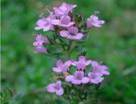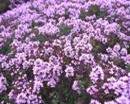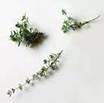| Kingdom | Plantae |
| Division | Magnoliophyta |
| Class | Magnoliopsida |
| Order | Lamiales |
| Family | Lamiaceae |
| Genus | Thymus |
| Species | T. vulgaris |
| Binomial name | Thymus vulgaris |
Other Common Names:
The other common names for the herb thyme are Black Thyme, Common Thyme, English Thyme, French Thyme, Garden Thyme, German Thyme, Serpyllum, Tomillo and Winter Thyme.
History
Thyme is the general name for the many herbs of the Thymus species, all of which are small, perennial plants native to Europe and Asia. Common or garden thyme is considered the principal type and is utilized commercially for flowering and ornamental purposes. The name Thyme, in its Greek form, was first given to the plant by the Greeks as a derivative of a word which meant 'to fumigate,' either because they used it as incense, for its balsamic odour, or because it was taken as a type of all sweet-smelling herbs.


Others derive the name from the Greek word thumus, signifying courage, the plant being held in ancient and mediaeval days to be a great source of invigoration, its cordial qualities inspiring courage. Thyme is also known as or 'Mother-of-Thyme.' derived from the use of the plant in uterine disorders and for its use in domestic medicine.
Description
Garden thyme is a low-growing perennial to around 40cm tall with fibrous roots and woody stalks. Tiny aromatic leaves are born on erect stems which are about 1/8 inch long and 1/16 inch broad, narrow and elliptical, greenish-grey in colour, reflexed at the margins, and set in pairs upon very small foot-stalks. Small lilac flowers are borne in summer and they are quite attractive.



Range
It was certainly commonly cultivated in England before the middle of the sixteenth century. Thyme is widely distributed in the mountains of Spain and other European countries bordering on the Mediterranean, flourishing also in Asia Minor, Algeria and Tunis. It is cultivated now in most countries with temperate climates including France, Spain, Portugal and Greece, as well as in the western U.S.
Habitat
It thrives best in sun in rocky or sandy soil with good drainage. The plant prefers neutral to alkaline soil. Thus garden thyme prefers light, well-drained, slightly alkaline soil.
Cultivation
Thyme requires a hot, sunny location and is at its aromatic best if grown in well-drained soils that are low in nutrients. It will thrive in stony soil and requires little watering once it is established. Garden thyme is propagated from seeds, stem cuttings, and layering. Through cutting clip a sprig of new growth from the top of the plant. Strip the leaves from the bottom of the twig and put it in wet sand to root. Layer stems in late spring. Pin down the lower branches of an existing plant. Cover the branch with soil, leaving only the tip exposed. Once the pinned branch has rooted, remove it from the main plant. Thyme is a sprawling plant, so you may find that branches that reach over and touch the soil develop roots. This is a natural form of layering. When this occurs, separate off and transplant the new "plantlets." At the close of the summer, as soon as the herbs have been cut sufficiently, the beds should be attended to, all weeds cleared away and the soil well forked on the surface. In winter, protect the plants from frost by banking up with earth. Thyme roots soon extract the goodness from the soil, hence whatever is sown or planted afterwards will seldom thrive unless the ground is first trenched deeper than the Thyme was rooted, and is well manured.Divide mature plants every 2 to 3 years to prevent them from becoming woody and straggly. New plants can easily be propagated by layering from an established clump or by dividing the plants and replanting rooted sections.
Flowering Season
The flowers are of the thyme are in full bloom in early summer.
Pests and Diseases
Thyme is virtually free of pests and disease, although they are occasionally attacked by greenfly.
Parts Used

The aerial parts of the plant and its oil are the most commonly used parts of the plant for its commercial and medicinal purposes.
Medicinal Applications

• It purges the body of phlegm, and is an excellent remedy for shortness of breath.
• It strengthens the lungs and is a good remedy for chin-cough in children.
• It kills worms in the belly, provokes the terms and gives safe and speedy delivery to women in labour.
• It relieves throat and bronchial irritation and the spasms of whooping cough.
• Thyme arrests gastric fermentation.
• It helps in healing leprosy.
• Oil of Thyme is employed as a rubefacient and counter-irritant in rheumatism, etc.
• Thymol is also employed as a deodorant and local anaesthetic.
• It is extensively used to medicate gauze and wool for surgical dressings.
• It is used as an antiseptic lotion and mouth wash; as paint in ringworm, in eczema, psoriasis, broken chilblains, parasitic skin affections and burns.
• It is most useful against septic sore throat, especially during scarlet-fever.
• Thyme helps in healing cuts, bruises, acne, rash and so forth on the skin, especially in the area of the face, neck, throat and forehead.
• The relaxing benefits of thyme can also be seen in the digestive tract, and used to good effect for wind and colic, irritable bowel syndrome and spastic colon.
• Thyme also acts as a cleansing liver tonic, stimulating the digestive system and liver function, making it useful for indigestion, poor appetite, anemia, skin complaints, lethargy, and gallbladder complaints.
• As a diuretic, thyme reduces water retention, infections of the urinary tract, rheumatism and gout.
• Thyme helps ringworm, athlete's foot, thrush, and other fungal infections, as well as scabies and lice.
Commercial Applications

• It was employed by the Romans to give an aromatic flavour to cheese.
• In Perfumery, Essence of Thyme is used for cosmetics and rice powder. It is also used for embalming corpses.
• The dried flowers have been often used in the same way as lavender, to preserve linen from insects.
• Thyme is principally in request for culinary requirements, for its use in flavouring stuffing's, sauces, pickles, stews, soups, jugged hare, etc.
• The essential oil of garden thyme is used to preserve processed meat and butter, and in making chewing gum, ice cream, candy, and the liqueur Benedictine.
• Thyme is used in potpourris and sachets.

Lady Northcote (in The Herb Garden) says that among the Greeks, Thyme denoted graceful elegance; 'to smell of Thyme' was an expression of praise, applied to those whose style was admirable. It was an emblem of activity, bravery and energy, and in the days of chivalry it was the custom for ladies to embroider a bee hovering over a sprig of Thyme on the scarves they presented to their knights. In the south of France, Wild Thyme is a symbol of extreme Republicanism, tufts of it being sent with the summons to a Republican meeting.
According to legend, any place where thyme grows wild is a place blessed by the fairies. The ancient Greeks burned thyme in their temples for consecration and purification, but also as an offering to the gods. It was especially sacred to Adephaghia, the Greek goddess of food and good eating. Modern pagans use thyme as a smuging herb to purify the space used for a magical ritual. Wear sprig of thyme in your hair to make yourself irresistible.
A pillow stuffed with thyme dispels nightmares and promotes safe, positive dreams. The best-known use of THYME is in Money-Drawing spells. Thyme is an ingredient in Three Jacks and King Oil, used by Gamblers to draw Money-Luck. Some people plant THYME in their gardens, saying that as it grows, their money will increase. Others take a dollar bill, fold it around THYME LEAVES, fold it again to make a packet, tie it up with green thread, and bury the packet in the middle of a Crossroads on the night of the Full Moon.